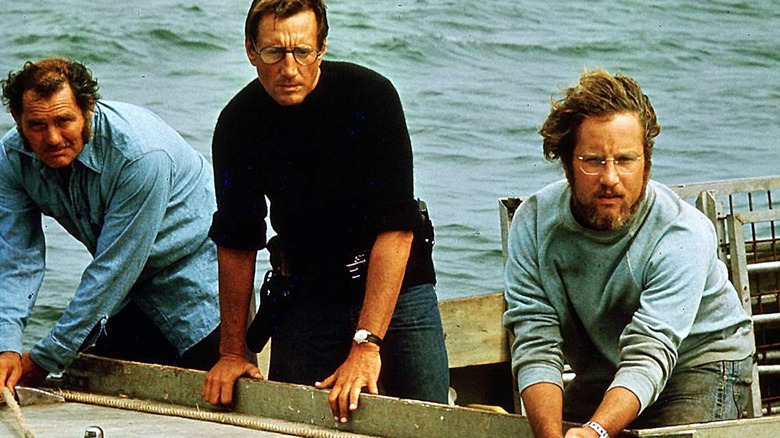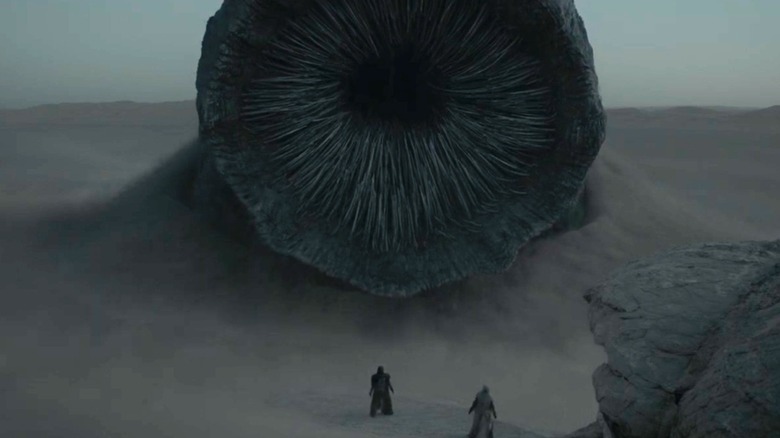Dune Took Inspiration From Jaws For One Of Its Most Thrilling Components
This post contains spoilers for Denis Villeneuve's "Dune" films.
When the Atreides first arrive in Arrakis in "Dune: Part One," we get our first glimpse of the mystical sandworms from the aerial perspective of a roving ornithopter. Duke Leto (Oscar Isaac) notices the steady advent of the creature beneath the sand, the disturbance caused by its hidden scale leading up to an awe-inspiring scene: a gigantic, bottomless mouth swallowing one of the spice harvesting machines. As the Atreides do not know much about the Fremen and their relationship with Shai Hulud at this point, this first introduction feels even more intriguing, with a decided air of danger encircling the mysterious worm-like creatures.
Denis Villeneuve maintains the mystique surrounding the sandworms in "Part One" with the aid of a simple, yet effective strategy, where small glimpses of the creatures are peppered throughout to build up to the stunning reveal when Paul (Timothée Chalamet) and Jessica (Rebecca Ferguson) stand face to face with one of them. It is an encounter that marks a turning point — the duo is now in Fremen territory, at the mercy of the desert and the secrets it holds, and the sandworm's silent, nonviolent appraisal of Paul hints at the world-altering role he is yet to play in the future. This brilliant build-up was overseen by special effects artist Paul Lambert, who explained that he and Villeneuve took the "Jaws" approach in terms of revealing the creatures in an impactful way (via Curzon):
"From the outset, we wanted it to be like 'Jaws.' Denis plays with this suggestion and gives you glimpses of them until finally, there they are."
Let us dive deeper into the "Jaws" comparison and how the sandworm sequences were filmed to simulate a seamless blend with the natural environment.
In both Jaws and Dune, less is more
The overwhelming terror gripping Steven Spielberg's "Jaws" does not lie in the scenes where the shark emerges and attacks but in the quiet anticipation surrounding the inevitable, where glimpses of the creature can be seen from time to time. The shark only has a 4-minute screen time in "Jaws," but this is enough to evoke fear and instill dramatic urgency, as Spielberg hones in on the paranoia of the unknown, where the turgid waters of the ocean become a source of constant anxiety. This also works in favor of the great reveal later on, which forms the memorable crux of "Jaws."
Villeneuve adopts a familiar formula in "Part One," where the reveal feels cathartic due to the stunning attention to detail imparted to the worm designs, which Lambert also talked about at length in the interview linked above:
"There was a lot of effort early on to get the look of them right. There were all these amazing designs, but we also had to think about how to make the worms move and how they could turn. Then there's the texture of the skin, which resembles solid plates with a soft mesh in between, sort of like an accordion...Denis wanted everything to be as grounded and as photoreal as possible. It meant coming up with techniques to make the best of the visual effects."
According to Lambert, these effects were "complex to achieve," but an expert blend of practical and computer-generated effects helped both "Part One" and "Part Two" transcend these limitations, with its sandworm scenes evoking a tangible sense of scale and spectacle amid the intense, layered human drama at the core of its being.

